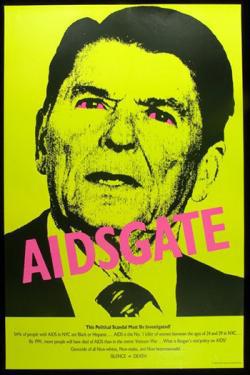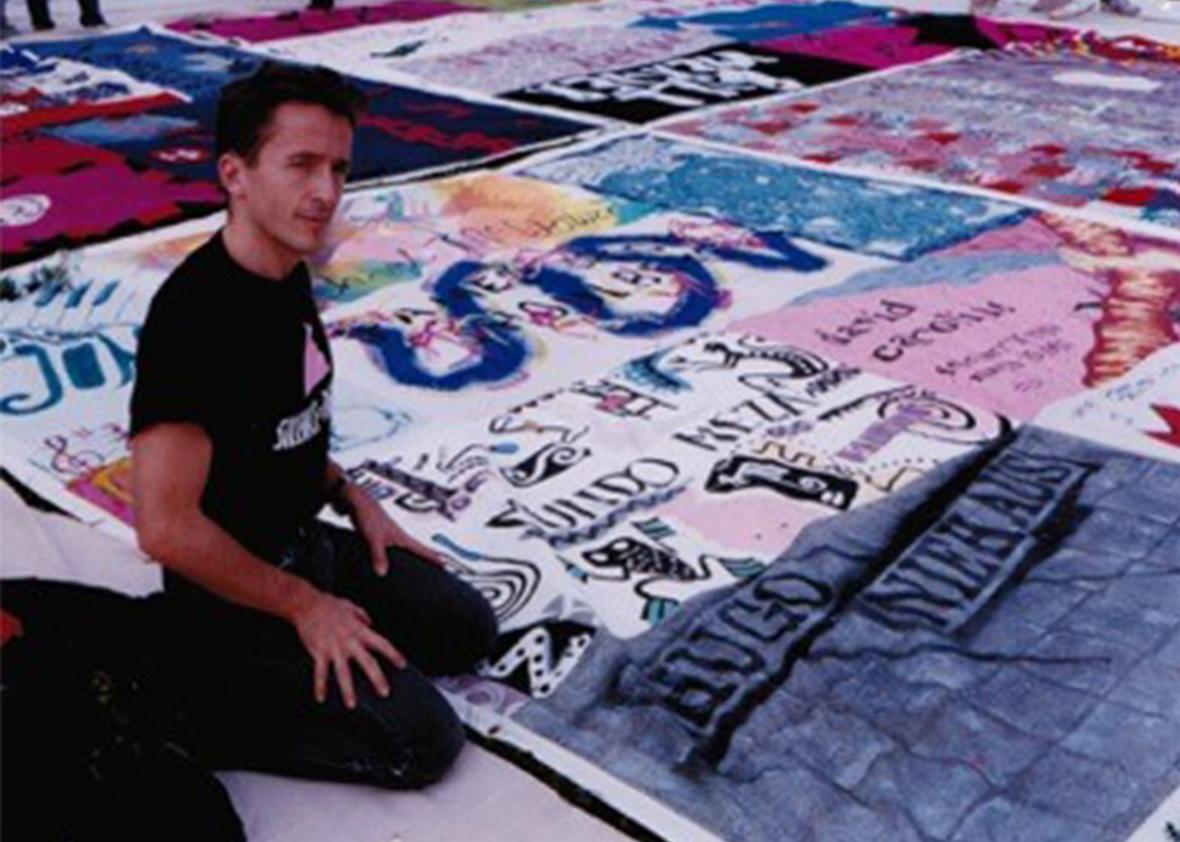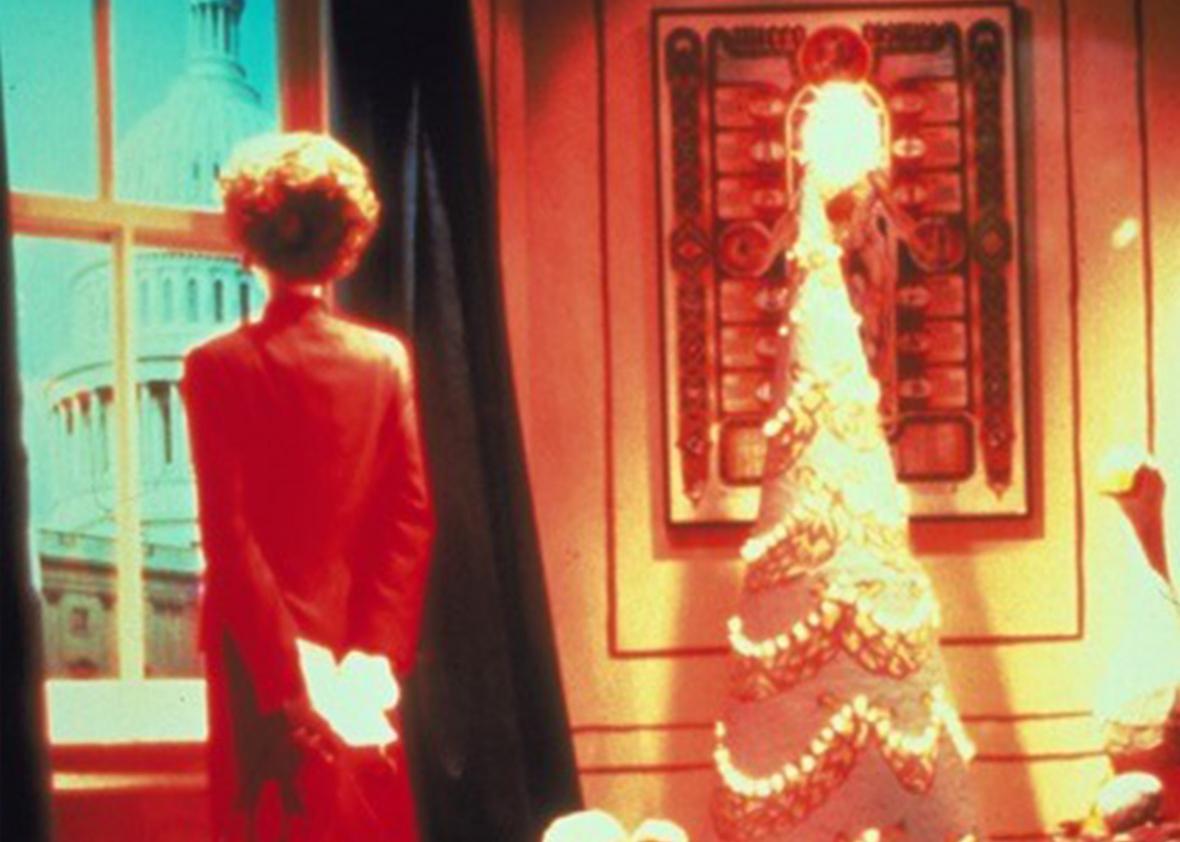I vividly remember the whole Reagan thingy. I was a recently green-carded immigrant, 28 years old, and living la vie bohème in West Hollywood. I was apolitical, wore punk and rockabilly clothes, and drank a lot. The notion of a former matinee idol running for president struck me as nothing short of hilarious. Totie Fields for vice president!
Two years after the Reagans had ensconced themselves in the White House, my ex-boyfriend–slash–roommate drew my attention to a nasty purple lump on his neck. La peste had arrived. Within a short period of time three more ex-boyfriends got sick. Colleagues and acquaintances developed coughs on Friday and were dead by Monday. Pain, horror, and misery became part of daily life. Many pals died without family support, funerals, or memorials. We were in our 20s, and one by one we were all slipping into an abyss. By 1985 those roomies, pals, and ex-boyfriends had all died horrible deaths (along with Nancy’s old friend Rock Hudson and thousands of others). Assuming I only had a few months left to live, I took the only course of action open to me: I escaped to New York to work for Diana Vreeland.
A year later I began dating AIDS activist and Gran Fury member Avram Finkelstein. “We have started a group called ACT UP. You should come to the next meeting,” he suggested. Suddenly I found myself shouting slogans, handing out fliers, and selling T-shirts and buttons bearing the SILENCE = DEATH logo. Political engagement was new to me. I felt like Barbra Streisand in The Way We Were. Though I threw myself into the ACT UP demos, I found the Monday night meetings profoundly bewildering. Much of the debate centered on the Reagan indifference to our situation. Why hasn’t Ronald Reagan spoken the word AIDS yet? Why has Nancy done nothing to draw attention to the plight of the afflicted? Everyone around me was mad as hell.
I, on the other hand, had become a grief-stricken fatalist. The world hates us, and we are all going to die, and that’s just the way it is. The New York subway is covered in graffiti. It will always be that way. That’s just the way it is. Of course the Reagans don’t give a shit about us. Nobody does. I lacked the vision to see that things could and should be different. I could not get mad. Thank God for Larry Kramer, Michael Petrelis, Steve Gendin, Avram, et al. They had vision. They screamed their brains out, banged their fists on tables, and expressed their rage about the Food and Drug Administration and the Reagans—and, slowly but surely, they changed the course of history. They were heroic.

Gran Fury/Simon Doonan
By this time I was working at Barneys, where I was head window dresser. One day my team and I were having a studio cleanup. We were about to throw a bunch of expired foam-core sale signs into a dumpster. I set them aside. The following Saturday I came to work and, armed with half a dozen cans of Spray Mount, I affixed the SILENCE = DEATH posters to the recycled boards. Up until this point these posters had been used solely for wheat-pasting on walls and on construction barricades around the city. Now, thanks to the Barneys sale signs, we could jiggle these images at demos. And they were double-sided.
The year 1987 was busy: After SILENCE = DEATH, the Gran Fury lads designed a Reagan-targeted campaign, an image of Ronald’s head with bloodshot eyes, emblazoned with the word AIDSGATE. Liberace and Michael Bennett both kicked the bucket. There was a march on Washington in tandem with the unfurling of the massive Names Project AIDS Memorial Quilt, which contained a panel that I had created to memorialize the death of that first pal. We waived our Spray-Mounted AIDSGATE posters. Ronald Reagan finally said the word AIDS.

Simon Doonan
And then, 1989. The Reagans were leaving the White House. I decided to celebrate with a sayonara Nancy window display. Creating a life-size Nancy caricature presented many challenges. I grabbed a petite window mannequin and redid the makeup à la Nancy. The result looked more like Buddy Hackett. Solution: Turn the broad around. Dressed in a red suit and wearing a fluffed-up, dime-store wig, my mannequin screamed Nancy. We placed back-view-only Nancy in the window. In my vignette she was staring wistfully toward the Capitol whilst clutching her airline ticket. I included satirical references to her red-and-white china debacle and to her much-mocked astrological passions. Was there a direct mention of the Reagan foot-dragging on AIDS? No. Why bum everyone out with those nasty statistics? Why get mad?
In 2007 I spent time in the White House. I had been hired to help with the holiday décor. In one of the corridors I came upon a full-length portrait of Nancy wearing a loose, floor-sweeping Adolfo shift. It resembled a Snuggie. I thought of my deceased pals. They did not live long enough to see the advent of Snuggies, or the Internet, or the dangling chads, or the explosion of the designer handbag and shoe business, or tribal tattoos, or gay marriage, or Homeland, or cellphones, or O.J., or Spanx, or Lady Gaga. How shocked they would be to see me skipping through the White House, with a black president in the Oval Office? I felt sad. But still I could not get mad.
Last week, Hillary Clinton had a break with reality. She eulogized Nancy Reagan for her “effective, low-key advocacy” for HIV/AIDS. Hillary’s attempt—speedily retracted, still mysterious—to repackage Nancy Reagan as a stealth Mother Teresa for the AIDS-afflicted had a strange effect on me. It released my Reagan rage. I snapped. I finally got mad.
Also in Slate
- Hillary Clinton Praises Reagans for Starting “a National Conversation” About AIDS. That’s Insane.
- Larry Kramer Responds to Hillary Clinton’s Reagan AIDS Advocacy Gaffe
- The Reagans Knew a Lot of “Discreet” Gays—Which Makes the Administration’s Failure on AIDS Even Worse
- Revisiting the Historical Record on HIV/AIDS, From Reagan to Clinton
